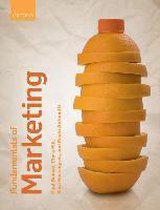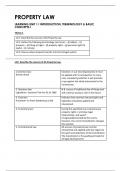Chapter 1: Marketing Principles and Society
Introduction
Marketing mix is the list of items that a marketing manager should consider when
devising plans for marketing products (product, price, place, and promotion). Market
orientation refers to the development of a whole-organization approach to the
generation, collection, and dissemination of market intelligence across different
departments, and the organization’s responsiveness to that intelligence. Relationship
marketing is the development of long-term relationships with customers. Service-
dominant logic asserts that organizations are concerned with exchange service, based
on the application of knowledge and service.
What is Marketing?
Marketing is a management process or activity. Promotion is the use of communications
to persuade individuals to purchase products and services.
A customer is a buyer, client, or shopper, who buys the product in a store, or via a
website. A consumer is someone who uses the offering.
Market orientation involves: customer orientation, competitor orientation, and
interfunctional coordination (all functions of the organization to work together).
Marketing developed in this order:
1. Production period (1890s-1920s)
2. Sales period (1920s-1950s), advertising is a form of non-personal
communication transmitted through the use of paid-for media.
3. Marketing period (1950s-1980s)
4. Societal marketing period (19802-present)
Marketing has developed with influences of industrial economics, psychological,
sociological, and anthropological. Social anthropology is the discipline of observing and
recording the way in which humans behave in different social groups. Ethnography is
the approach to research in which subcultural groups are observed. Netnography is the
brand of ethnography that seeks to analyze Internet users’ behavior.
Procurement is the buying process in a firm or organization. Marketing is distributed
throughout the organization and all employees can be considered to be part-time
marketers.
The Principles of Marketing
Generalization 1: advertising has a direct and positive influence on total industry sales.
Generalization 2: selective advertising has direct and positive influence on individual
company sales
Generalization 3: the elasticity for selective advertising is low (inelastic)
,Generalization 4: increasing store shelf space (display) has a positive impact on sales of
non-staple grocery items, which are products that are not a main or important food.
Generalization 5: distribution has a positive influence on company sales
Marketing can be seen as a two-way exchange process (dyadic); it provides an income
for the marketer, and helps to create awareness for the second company.
The marketing mix consists of: product, place, price, and promotion. There is also an
extended marketing mix for services: product, place, price, promotion, physical evidence,
people, and process.
Physical evidence: to emphasize the tangible components of services, that is to
see where the service takes place, and how to recognize quality (servicescape)
People: the importance of customer service personnel (e.g. training)
Process: to emphasize the importance of service delivery, designed to meet
customers’ needs
Marketing’s Positive Impact on Society
The aggregate marketing system works well in most countries, but there are countries
where marketing is influences by political and environmental circumstances.
Unsustainable Marketing: The Critical ‘Turn’
Marketing serves the common good, but also creates needs and manipulates customers.
Framing is the action of presenting persuasive communication; it takes place via
situations, choices, issues, actions, responsibilities, and news.
The marketing system persuades people into buying products they do not need, or by
changing their perceived product-value. This indicates that even though a product is bad
for your health, the marketing system will still distribute it.
Sustainable Marketing
Sustainable marketing are the activities undertaken to meet the wants or needs of
present customers without compromising the wants or needs of future customers, in
relation to negative environmental impacts on society. It has been termed the ‘third age’
of green marketing
There are three factors: ecological (positive impact upon the environment), equitable
(not allow inequitable social practices), and economic (encourage long-term economic
development).
Positioning is the way in which the consumers perceive a product. Supply chain
management is the coordination of supply-side activities from production to
consumption to enhance customer value. Reverse logistics is the process of returning
goods in a physical distribution channel. Circular economy means trying to keep the
product for as long as possible by reusing and recycling. Collaborative consumption is
the trend towards sharing, swapping, and renting of products.
,Corporate Social Responsibility
Corporate social responsibility (CSR) is a program of social/environmental activities
undertaken by a company to develop sustainable business operations.
Ethics and Marketing
Ethics: moral principles that govern a person’s behavior of the conducting of an activity.
Chapter 2: Understanding Customer Behavior
Introduction
Cognition is a psychological term relating to the action of thinking about something
(just like our opinions). Perception is a mental picture based on existing attitudes,
beliefs, needs, stimulus factors, and factors specific to our situation, which governs our
attitudes and behavior towards objects, events, or people in the world about us.
Personality influences our psyche, which determines the way in which we respond to
our environment in a relatively stable way over time. Social class is a system of
classification of consumers, based on the socio-economic status of the chief income
earner in a household.
Consumer Proposition Acquisition (customer perspective)
Motive development: deciding that the customer
wishes to obtain an offering. This involves a problem
that needs to be solved.
Information gathering: we seek alternatives of solving
our problem. In this stage a lot of questions are asked:
where did I buy the last [product]? How much am I
willing to pay for [product]? Overt search is the point
in the buying process at which the consumer seeks
further information in relation to a product or buying
situation.
Proposition evaluation: when we have all the
information needed, we rank various offerings
through the important criteria. These might be
rational (based on cost), or irrational (based on desire
or intuition). Value is the regard to which something
is held, typically expressed in financial terms. Evoked set is a group of goods,
brands, or services for a specific item brought to mind in a particular purchasing
situation, from which a person makes a decision to which product, brand, or
service to buy.
Proposition selection: the offering that we select, meets our criteria the most.
This stage is used for re-evaluating what we buy, because it might not be available
in store.
Acquisition/Purchase: once the selection has taken place, different approaches to
purchasing might exist. Purchases might be made regularly, or more on an
, infrequent basis (which would make us much more involved in the decision-
making process to understand what we are buying).
Re-evaluation
Cognitive dissonance states that we are motivated to re-evaluate our beliefs, attitudes,
opinions, or values if the position we hold on them at one point in time does not concur
with the position held at an earlier period owing to some intervening event,
circumstance, or action. Attitude refers to the mental states of individuals that underlie
the structuring of perceptions and guide behavioral response. Opinions refer to
observable verbal responses given by individuals to an issue or question; easily affected
by current affairs and discussions with significant others.
To reduce dissonance we:
Selectively forget information
Minimize the importance of an issue, decision, or act
Selectively expose ourselves to new information consonant with our existing view
Reverse a purchase decision
Involvement means the greater personal importance people attach to a given
communication message, the more involvement they are said to have with that
communication. A high-involvement purchase, such as a car has a greater feeling of
making the right decision.
If we actually like a product, we might repurchase it, this is called the loyalty stage. In
this stage, we also might encourage others to buy this product. UGC means user-
generated content.
Perceptions, Learning, and Memory
The involvement a potential buyer has, explains a person’s receptivity to
communications, this can either be high, medium, or low. Organizations deliberately
seek to position themselves in the minds of specific target audience groups.
Consumers can learn through the following:
Classical conditioning: a theory that suggests that our unconditioned stimulus
becomes associated with the conditioned stimulus.
Operant conditioning: a theory that suggests that when a subject acts on a
stimulus from the environment, this is more likely to result in a particular
behavior if that behavior is reinforced through reward or punishment.
Social learning: a theory that suggests that we can learn from observing the
experiences of others, and that we can delay gratification and even administer
our own rewards or punishment.
We enhance memorization by using symbols and repeating them. The memorization
processes that can affect consumer choice are:
Factors affecting recognition and recall: less frequently used words in advertising
are recognized more and recalled less.




